Festivals
London Film Festival 2011: The S&S blog
They live! Treasures from the archive
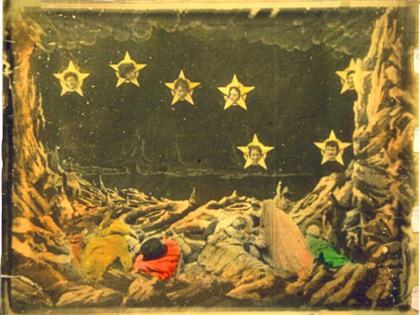
Georges Méliès’s restored Journey to the Moon
James Bell, 1 November
Surrounded by so many attention-grabbing new films, the LFF’s ‘Treasures from the Archive’ programme can sometimes seem like a separate mini-festival all of its own, operating in parallel to the main event, and tucked away from the glare of Leicester Square under Waterloo Bridge at the BFI Southbank. It has its own meet-and-greets, but the stars of the show aren’t usually the visiting cast or directors so much as the archivists and restorers from various film archives across the world, in town to present selections of their past year’s work.
I’ve always found Treasures from the Archives is the first section I turn to when the festival catalogue arrives. This year Clyde Jeavons, the section’s programmer, brought together an enticing range of films that reached right back to the very beginnings of cinema, with a screening of a beautifully restored version of Georges Méliès’s 1902 Journey to the Moon (Voyage dans la lune) – soon, if reports are to be believed, to be paid tribute to in Scorsese’s imminent Hugo 3D.
I didn’t manage to get along to get to every film in the programme, but saw a fair few of them, and single out some personal highlights below.
The programme opened with a screening of Clarence Brown’s 1925 silent The Goose Woman, introduced by the print’s chief restorer, Robert Gitt, and accompanied on piano and flute by Stephen Horne. The film boasts a wonderfully cantankerous performance by Louise Dresser as Mary Holmes, an embittered, forgotten-presumed-dead opera singer whose career had faltered many years previously after she gave birth to an illegitimate son, who she then raised with bitter resentment. (The grown son was played by Jack Pickford, Mary’s brother.)
Drinking her life away in a decrepit house, and surrounded by the geese that provided her nickname, Dresser’s character spots a chance to grab some celebrity when she claims to have seen a murder take place near her property. (The story was inspired by an infamous real-life case from 1922, when a ‘witness’ dubbed ‘The Pig Woman’ concocted a story to win herself attention.) But despite managing to revive her stardom, the plan turns sour when she inadvertently puts her son in the frame, before the inevitable and emotional reconciliation at the end of the film.
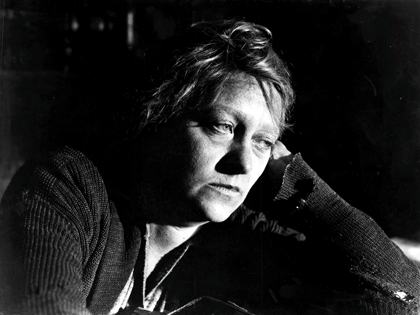
The Goose Woman
Brown – who would become ‘Garbo’s director’, directing her in films such as Flesh and the Devil, A Woman of Affairs and Anna Christie, and would also introduce Elizabeth Taylor to the world in National Velvet – handles the story well, and teases out the humour in his focus on a number of little details like the hiding of a whiskey bottle. Still, it’s Dresser’s performance that lingers in the memory afterwards. As Robert Gitt noted in his introduction, had the Oscars started in 1925 rather than 1927 she would have been a shoo-in for Best Actress.
The feature was preceded by two early Vitaphone sound shorts, both from 1928: The Wild Westerner, a hilarious little skit about a randy old cowboy (Val Harris) trying to chat up a pretty young flapper (Ann Howe), and I Thank You, in which the incredibly eager Eddie White delivers his one-man vaudeville act – a string of ethnic gags and songs, all closed with the slurred sign-off “I thank you!”. According to Gitt, Smith was 26 at the time he made the film, but he looked more like a pimply 15-year old, adding to his winningly awkward screen presence.
Also from the 1920s, but an entirely different proposition, was the Wonderful London screening, which showed new restorations by the BFI National Archive of six of the documentary films made in the ‘Wonderful London’ series by directors Harry B. Parkinson and Frank Miller. Essentially travelogues around the capital in the mid-1920s, these showed the expected sights of the bustling Strand and Piccadilly Circus – but also, fascinatingly, the multi-ethnic Soho of the time, dockers working in the Port of London, and a barge trip up the Regents Canal from Limehouse to Paddington Basin via Kings Cross and Camden Town. It was an uncanny, magical sight to see such familiar places as they once had been.

Cosmopolitan London
The films had been restored with their original colour-tinting reinstated. A DVD will hopefully follow, and would be an essential addition to the groaning shelves of books on London’s vanished past. The BFI’s Bryony Dixon warned us in her introduction that some of the films would reveal the racist attitudes of the time, and one sequence of Chinese immigrants in the old Limehouse Chinatown offered particularly offensive intertitles. Neil Brand, accompanying the films on piano, handled such potentially difficult moments with tact and sensitivity.
My personal highlight of the Treasures section, and of the festival overall, was a revival of a more recent film than most in the programme, Barbara Loden’s still startlingly raw directorial debut Wanda, shot on location in a drab Pennsylvania of sleazy bars, cheap motels and towering slag-heaps in 1969.
Loden herself had started out as a model and actress, though was best known for her marriage to Elia Kazan, and for staring in two of his films – Wild River and Splendor in the Grass, in the latter as Warren Beatty’s sister. As UCLA film archivist Ross Lipman suggested in his introduction to the Wanda screening, it was perhaps that acquaintance that led Beatty the producer to consider her for what ultimately became Faye Dunaway’s part in the 1967 generation-definer Bonnie and Clyde. Loden however refused his offer, and was later critical of the result, reasoning that people who go cross-country robbing and killing simply do not look so pretty, or exude such potent charisma. So it’s tempting to view the very existence of Wanda as something of a reaction; Loden even described it in interviews at the time as “the anti-Bonnie and Clyde”.
Loden herself plays Wanda, a directionless woman who’s pretty much a blank space as a personality. She’s easily manipulated and weak, a naïf. She even welcomes a judge’s decision to deny her access to her child, after which she heads out on the road, eventually taking up with a pathetic, unattractive yet violent middle-aged crook (Michael Higgins) who drags her into his life of petty crime.
Wanda at first seems not to know or care about what he’s up to, and later only offers meek protests when he coerces her into participating in what he thinks will be his big score, asking her to stuff a pillow up her jumper and pretend to be pregnant so as to reassure a bank-manager’s family whose home he’s about to invade, holding them to ransom while he sets off on a hopelessly disorganised and doomed robbery.
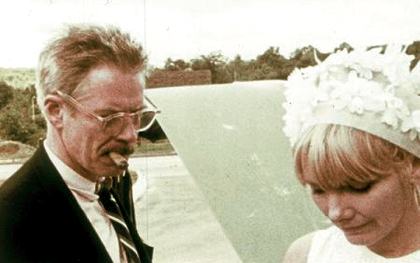
Wanda
This is surely what the great majority of petty crime is like, though the movies seldom admit it: not the crime-as-sex metaphors of Bonnie and Clyde, nor the sleek-professional fantasies of Michael Mann’s Heat, but desperate, unintelligent and character-lacking people falling into bad situations. Loden’s film is absolutely uncompromising, but most refreshingly it doesn’t revel in that lack of compromise; there’s nothing affected, vain or sanctimonious about its roughness.
The film has long had a strong reputation as a cult classic (Jonathan Rosenbaum has cited it as one of the 100 greatest American films, and it’s also a favourite of the LFF’s departing Artistic Director Sandra Hebron), but its influence feels more vital and pervasive today than ever before; Kelly Reichardt’s trip into the bleak heart of contemporary middle-America Wendy and Lucy, for one, owes it an undeniable debt. Here’s hoping Wanda is given a more extensive re-release soon.
Loden’s own career sadly petered out afterwards; Wanda was the one and only feature she would direct, and after making a couple of shorts in 1975 she died young of cancer in 1980.
Similarly uncompromising and original was the American documentary filmmaker and politically radical agitator Emile de Antonio, whose incendiary and landmark 1964 documentary on the televised 1954 Army-McCarthy hearings Point of Order! also screened in the Treasures programme. Ross Lipman introduced it, having again supervised its restoration.
De Antonio later went on to make In The Year of the Pig (1968), the rigorously intelligent, clear-headed polemic about the origins, slow unfurling, and shocking events of the Vietnam war, as well as a number of other incisive documentaries, Millhouse and Underground among them.
Like In the Year of the Pig, Point of Order! displays a masterful construction of archive footage, deploying vertical editing in such a way as to leave you in no doubt as to the through-line and polemical power of its argument. What distinguishes it is that Antonio shot no new interviews; the material is all gleaned from the 40 days worth of television broadcasts of the hearings in 1954 – brilliantly edited-down to 97 minutes by editor Robert Duncan – during which McCarthy was gradually exposed to the TV-watching American people as the fanatical and ruthless bully that he was.
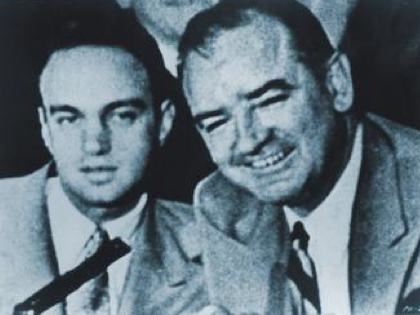
Point of Order!
Aside from a brief narrated introduction and onscreen text, the rest of the film passes without any ‘voice of God’ interventions. Nevertheless, we are utterly compelled as we watch McCarthy slowly hang himself, and observe tempers fraying, most famously when Army counsel Joseph Welch, challenging Senator McCarthy over his ruthless smearing of a bright and promising young man, whose career he had all but fatally destroyed, rhetorically asks, “Let us not assassinate this man further, Senator. Have you no sense of decency, sir, at long last? Have you left no sense of decency?” (The scene is also cited in George Clooney’s Goodnight, and Good Luck.) That one moment is often held as the final blow to McCarthy’s reputation and a seminal moment in US television history, for it proved the great power the new medium had on swaying public opinion.
In his introduction, Lipman explained how the film arose out of a conversation between de Antonio and Dan Talbot, the owner of the now famous New Yorker Theater cinema and soon-to-be founder of the New Yorker distribution company, which did so much to import and distribute foreign and arthouse cinema in the US from the mid-60s. The pair were discussing the power of television, and both agreed that the 1954 hearings had been the most decisive moment to date in showing the medium’s importance. Their decision to co-produce the film was made partly to provide a film to screen in Talbot’s cinema.
De Antonio is a major documentary filmmaker in need of greater exposure in the UK, and Point of Order!’s pioneering example seems especially current in light of such recent films as Andrei Ujica’s The Autobiography of Nicolae Ceausescu, similarly constructed only out of archive footage.
There was lighter fun to be had on the second Saturday of the festival. First up was an afternoon screening of a restored print of Edward Dmytryk’s Technicolor The Caine Mutiny, whose overblown bluntness and ‘weekend afternoon dad-movie’ clichés were at least offset by Humphrey Bogart’s fine performance as the psychologically troubled Navy Captain Queeg.
Much better was the evening screening of the long-forgotten Cry Danger, a cracking, no-flab crime film from 1951 and the directing debut of former editor Robert Parrish. Dick Powell stars as a man fresh out of a five-year stretch in the slammer for a crime he didn’t commit who sets about uncovering the crooked gang who set him up, while also hooking up with his old hard-drinking buddy Richard Erdman and former-flame Rhonda Fleming.
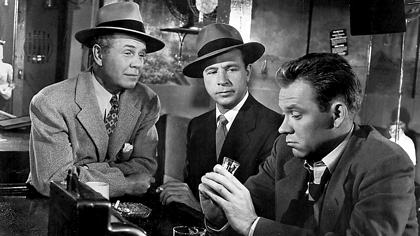
Cry Danger
The whip-smart script by William Bowers had the NFT enraptured from the off – you could feel everyone trying to commit the best wisecracking lines to memory – and it also made fascinating use of its Los Angeles locations, including many scenes shot around the now-demolished Bunker Hill district. (Curiously, Cry Danger wasn’t cited in Thom Andersen’s essay-documentary Los Angeles Plays Itself, which devoted a whole section to films shot in the district.)
I also made it along to fine restorations of Elia Kazan’s epic and deeply autobiographical America, America, with its stunning monochrome cinematography from Haskell Wexler, and to Mizoguchi Kenji’s occasionally sublime – if untypical in its colour-photography – Shin-heike Monogatari (Tales of the Taira Clan).
Both the Archive Gala screening of Miles Mander’s The First Born and Nicholas Ray’s restored We Can’t Go Home Again have already been discussed on this site during the LFF. My biggest regret was missing the World Cinema Foundation’s restoration of Turkish director Omer Lüfti Akad’s 1966 film Law of the Border, reportedly a key film in the New Turkish Cinema movement of the 1960s, and exactly the kind of historical revival that makes the LFF’s Treasures programme so essential: revealing the great untapped and still uncharted depths of world cinema history, while also reminding us how precarious the survival of even the most celebrated films can still be.
« Across the universe: Braden King’s HERE
The new new Argentine cinema »
See also
Time after time: The Innovators 1900-1910: Charles Musser on the storytelling achievements of editing pioneer Edwin S. Porter (March 1999)
Starmaker: Gwenda Young on the underrated Clarence Brown (April 2003)
So many moustaches!: Nick James introduces the wonders of Mitchell & Kenyon (January 2005)
‘Underground’, overground: Nick Bradshaw and James Bell on two archives showcases at the London Film Festival (October 2009)
Thunder roads: Michael Atkinson on gangsters, the Great Depression and America’s nomad soul (August 2009)
What time is it where?: Christian Marclay talks to Jonathan Romney about The Clock (May 2011)
The Elia Kazan Collection reviewed by Graham Fuller (February 2011)
Artist of the floating world: Alexander Jacoby on Mizoguchi Kenji (April 2008)
